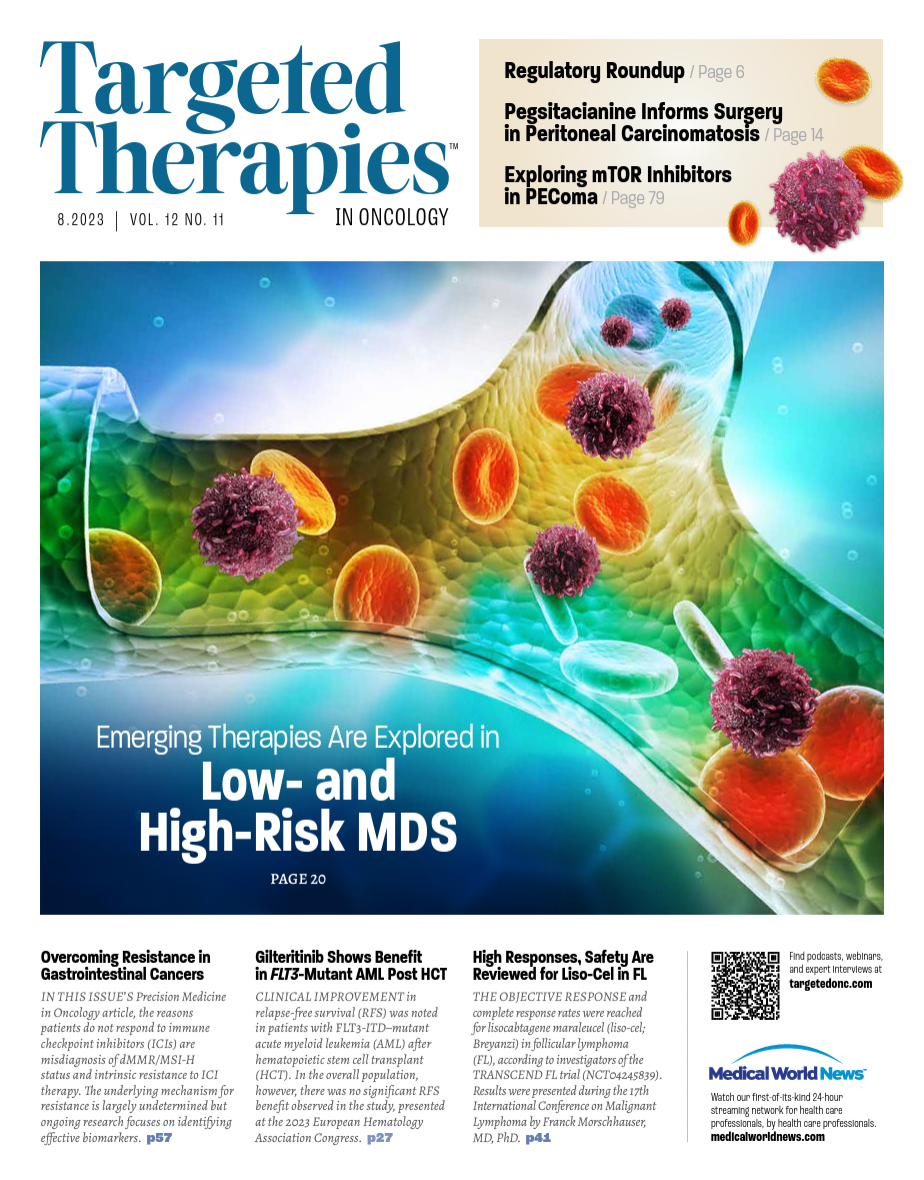Clinically Meaningful Activity Is Observed for Liso-Cel in Relapsed/Refractory MCL
Lisocabtagene maraleucel showed activity in patients with relapsed/refractory mantle cell lymphoma, according to findings from the TRANSCEND-NHL-001 study.
Michael Wang, MD
Professor of Medicine
Department of Lymphoma and Myeloma
The University of Texas MD Anderson Cancer Center
Houston, TX

Across all prespecified subgroups, lisocabtagene maraleucel (liso-cel; Breyanzi) resulted in clinically meaningful activity in patients with relapsed/refractory mantle cell lymphoma (MCL), particularly in the primary and secondary end points of overall response rate (ORR; 86.5%; 95% CI, 76.5%-93.3%) and complete response (CR) rate (74.3%; 95% CI, 62.8%-83.8%; P < .0001 for both). Michael Wang, MD, professor of medicine, Department of Lymphoma and Myeloma, The University of Texas MD Anderson Cancer Center, Houston, presented findings from the primary analysis of the MCL cohort of the TRANSCEND-NHL-001 study (NCT02631044) during the 17th International Conference on Malignant Lymphoma in Lugano, Switzerland.
After screening, patients underwent lymphodepletion, which included 30 mg/m2 fludarabine and 300 mg/m2 cytarabine for 3 days. This was followed by infusion with liso-cel from 2 to 7 days after lymphodepletion. Patients were infused with 50 × 106 CAR T cells (dose level 1) and 100 × 106 CAR T cells (dose level 2). Eligible patients had to have PET-positive MCL with confirmed tissue diagnosis; received 2 or more lines of therapy, including a Bruton tyrosine kinase (BTK) inhibitor, alkylator agent, and CD20-targeted agent; and an ECOG performance status of 0 or 1.
The primary end point was safety and ORR; secondary end points were CR, duration of response (DOR), progression-free survival (PFS), and cellular kinetics. In the liso-cel–treated arm (n = 88), the median age was 68.5 years (range, 36-86) and the median number of prior lines of systemic therapy was 3 (range, 1-11). Twenty-six patients had received 5 or more lines of therapy, and 29 patients (33%) had received prior autologous or allogeneic hematopoietic stem cell transplantation. Eighty-three (94%) patients were treated with a prior BTK inhibitor and 75% received ibrutinib (Imbruvica).
“Liso-cel delivered high overall response rate and complete response rates in patients with relapsed/refractory MCL,” Wang said. Further, 6.8% of patients had stable disease (SD), 0% had progressed, and 6.8% were not evaluable. In the efficacy analysis arm (n = 83), the ORR was 83.1% (95% CI, 73.3%90.5%) and the CR rate was 72.3% (95% CI, 61.4%-81.6%).
Regarding tumor burden, Wang said most patients experienced a reduction in lymphadenopathy; there were 57 patients reporting a CR, 8 reporting a partial response, 2 patients with SD, and 2 with progressive disease. When reviewing ORR by prespecified subgroups, the ORR was consistent in patients 75 years or younger, regardless of prior transplant status, secondary lymphoma status, TP53 mutation, and bridging therapy.
“Bridging therapy did not affect overall survival [OS],” Wang said. “Most importantly, among the 7 patients with CNS [central nervous system] mantle cell lymphoma, 6 out of 7 had a response rate of [nearly] 86% without additional toxicities,” Wang continued. After a median follow-up of 22.8 months (95% CI, 16.7-23.0), the median DOR was 15.7 months for all patients and 16.8 months for those with a CR.
After a median follow-up of 23.5 months, the PFS was 17.8 months (95% CI, 8.3-24.9) in patients with a CR and 15.3 months for all patients. Wang noted that after a median follow-up of 24.0 months, median OS among patients with a CR was 36.3 months (95% CI, 15.7-not reachable [NR]) and 18.2 months (95% CI, 12.9-36-3) for all patients.
“As most patients were enrolled during the COVID-19 pandemic, DOR, PFS, and OS were also analyzed with censorship of the 6 patients in ongoing CR who died because of COVID-19,” Wang said. “The median PFS improved from 15.3 to 17.8 months and the median OS improved from 18.2 months to 24.8 months.”
The most common treatment-emergent adverse events (TEAEs) for all grades were cytokine release syndrome (CRS; 61%), neutropenia (59%), anemia (44%), and fatigue (35%).
The most common grade 3 or higher TEAEs were neutropenia (56%), anemia (37.5%), thrombocytopenia (25%), and hypophosphatemia (9%). The maximum tolerated dose was not reached. Among 31 dose-limiting toxicity (DLT)-evaluable patients, 2 experienced a DLT at dose limit level 2. Four patients (4.5%) experienced a grade 5 TEAE with 3 of those were considered related to liso-cel.
“Treatment with liso-cel resulted in rapid, high rate of durable CR with a manageable safety profile in patients with heavily pretreated relapsed/refractory MCL,” Wang said. “Liso-cel was well tolerated with a low risk of CRS, neurotoxicity, and infections, suggesting that this might be a potential new treatment option for this population,” Wang concluded.
REFERENCE
Wang M, Siddiqi T, Gordon LI, et al. Lisocabtagene maraleucel in R/R MCL: primary analysis results from the MCL cohort of the single-arm, multicenter, seamless design TRANSCEND NHL 001 study. Presented at: 17th International Conference on Malignant Lymphoma; June 13-17, 2023; Lugano, Switzerland. Accessed July 1, 2023. https://bit.ly/3pzGEYt

Survivorship Care Promotes Evidence-Based Approaches for Quality of Life and Beyond
March 21st 2025Frank J. Penedo, PhD, explains the challenges of survivorship care for patients with cancer and how he implements programs to support patients’ emotional, physical, and practical needs.
Read More